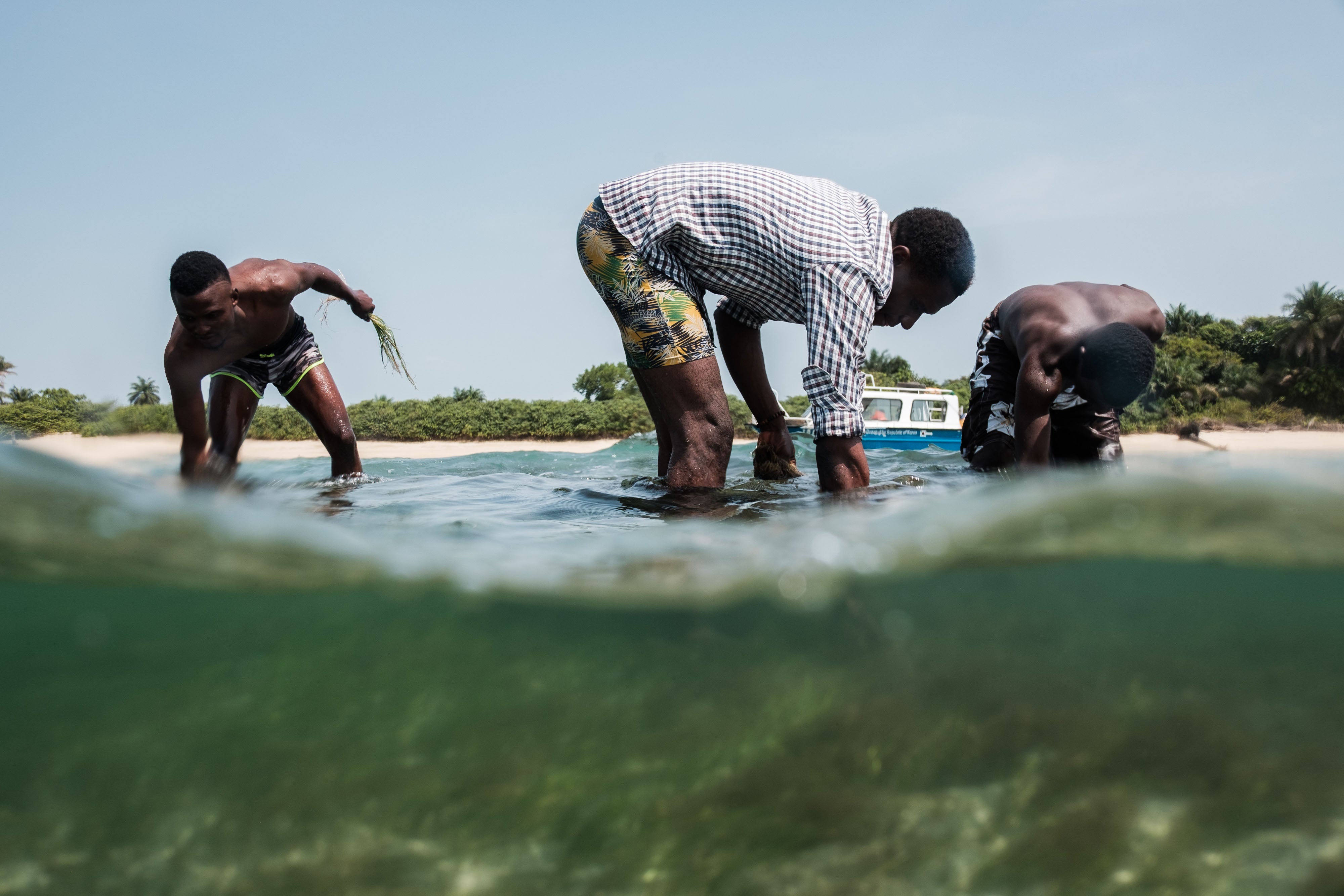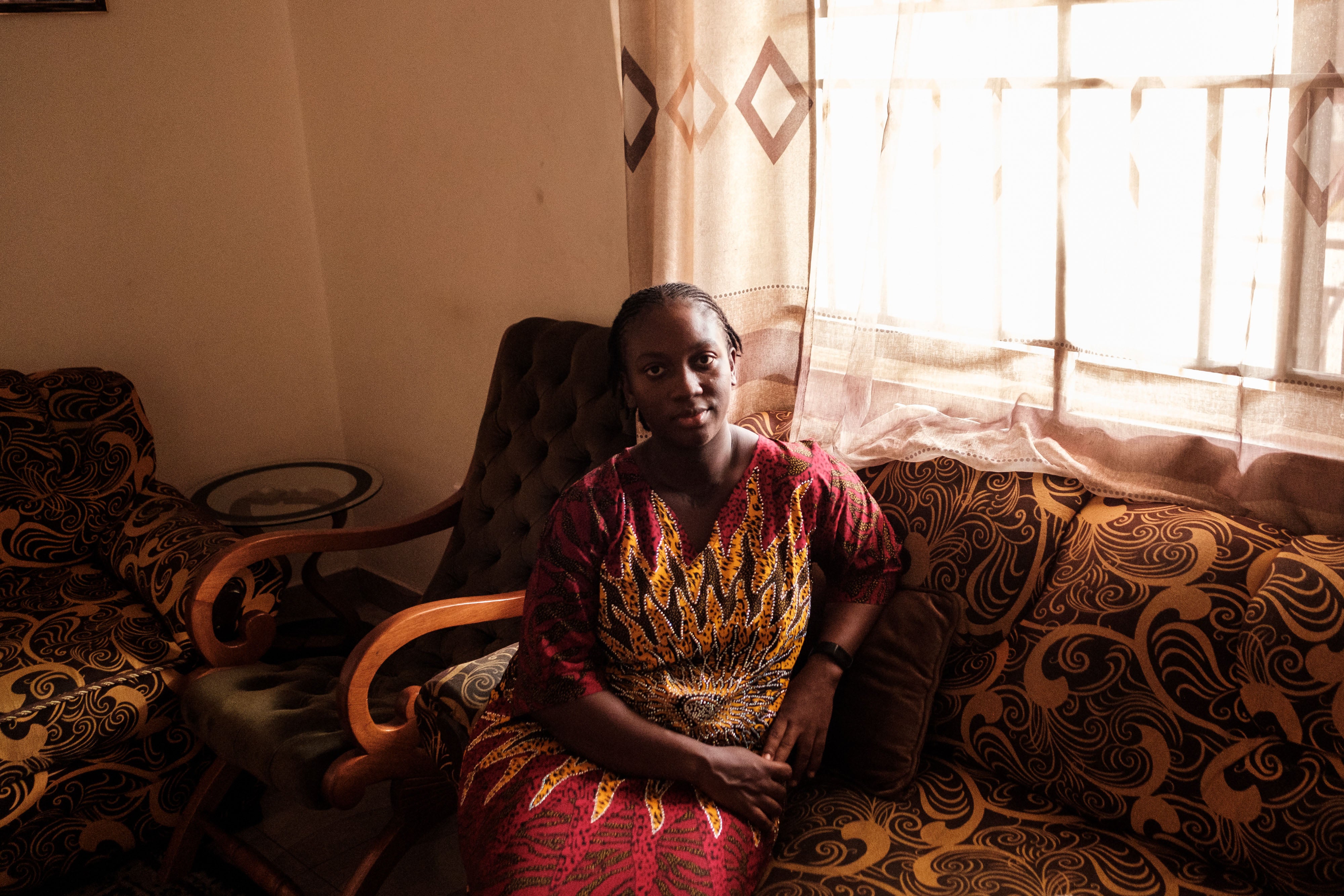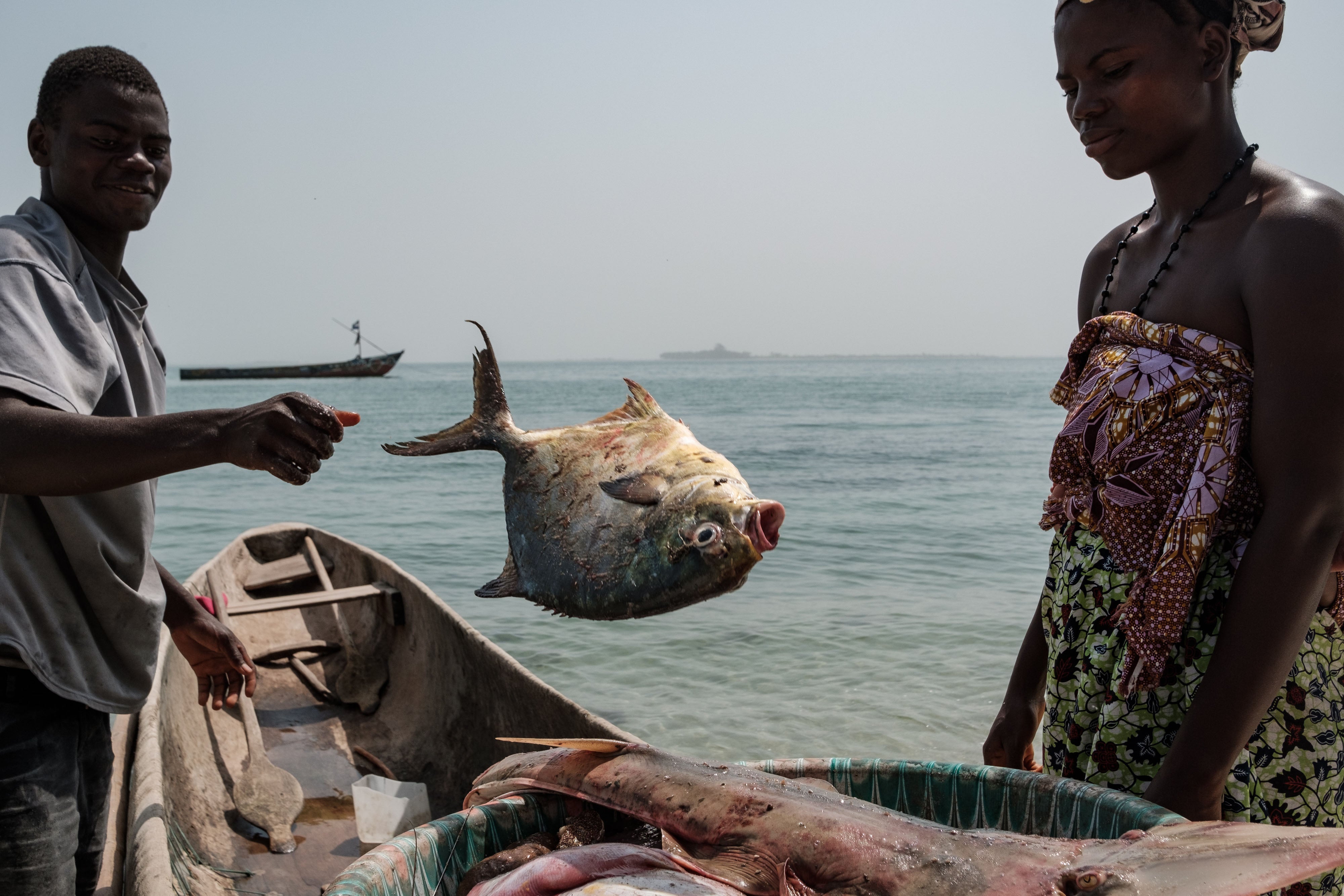A race to map the world’s seagrass – before it disappears
From the leaves down to the roots, these unassuming plants work as ‘ecosystem engineers’, yet they’ve become one of the least protected species of coastal life, writes Allyson Chiu

From the deck of a small blue-and-white boat, Bashiru Bangura leaned forward and peered into the ocean, his gaze trained on a large dark patch just beneath the jade-green waves.
“It’s here! It’s here! It’s here!” crowed a local fisherman, who led Bangura to this spot roughly 60 miles off the coast of Freetown. “It looks black!”
Bangura, who works for Sierra Leone’s Environment Protection Agency (EPA), tempered his excitement. After two unsuccessful attempts to find seagrass in this group of islands, he questioned whether the shadowy blotches were meadows of the critical underwater greenery he and other researchers have spent the past several years trying to locate along the coast of West Africa.
It was only once he was standing in the waist-high water, marvelling at the tuft of scraggly hair-like strands he’d uprooted to collect as a sample, that he allowed himself to smile.
The wet, reedy plants Bangura held in his hands were unmistakably seagrass, and the green blades stretched past the plastic 12in ruler he’d been using to measure specimens. His grin grew even wider.
The dense grass swaying in the current appeared to be healthy, and the water teemed with schools of small, silvery fish, making it the best site researchers have documented in these islands since the existence of seagrass was first confirmed in Sierra Leone in 2019.
“Discovering that site, it was a great moment for us,” Bangura said.
Seagrasses – which range from stubby sprout-like vegetation to elongated plants with flat, ribbon-like leaves – are one of the world’s most productive underwater ecosystems. The meadows are vital habitats for a variety of aquatic wildlife. Sometimes described as “the lungs of the sea” the grasses produce large amounts of oxygen essential for fish in shallow coastal waters.
But, long overlooked, these critical ecosystems are vanishing. In fact, researchers don’t know exactly how many exist or have been lost. One recent study estimated that since 1880, about 19 per cent of the world’s surveyed seagrass meadows have disappeared – an area larger than Somerset – partly as a result of development and fishing.
“When you lose foundation species like seagrasses ... then you lose fisheries really quickly,” said Jessie Jarvis, a marine ecologist who, until recently, headed the World Seagrass Association. “You see declines in water quality. You see nutrient-cycling stop. You see carbon being released back into the atmosphere.”
But locating grasses in the world’s vast oceans is a formidable task. While some researchers are using drones and satellite imaging, in countries such as Sierra Leone, where resources are scarce, the search is painstaking and tedious.
Without these efforts, though, seagrasses would probably be disappearing even faster.
“What we don’t know, we can’t protect,” said Marco Vinaccia, a climate change expert with GRID-Arendal, an environmental non-profit that helped put together West Africa’s first seagrass atlas.
Often found in coastal waters, seagrasses are an evolutionary wonder. Tens of millions of years ago, the flowering plants migrated from land into the oceans. Similar to terrestrial plants, seagrasses have roots, leaves, flowers and seeds.
Seagrasses have been discovered in the waters off more than 150 countries on six continents. The meadows are estimated to cover more than 300,000 square kilometres (approximately 116,000 square miles), an area the size of Germany. Along with mangroves, kelp forests and coral reefs, these grasses play a vital role in maintaining healthy oceans, Jarvis said. But unlike those other ecosystems, she notes, the meadows can exist in a wider range of ocean environments and tend to be more resilient than most species of seaweed.
Critters, such as seahorses, crabs and shrimp, along with juvenile fish – some of which are critical species for fishing – often lurk within the thick meadows, seeking refuge beneath the underwater canopy. Other creatures, including sponges, clams and sea anemones, can be found nestled between the blades of grass or in the murky sediment at the base of the plants. And much as mosses coat trees, many species of algae grow directly on the leaves.
Seagrass beds can in turn attract larger animals, including turtles and manatees, that stop by to munch on the leaves and stems.

“It’s a species that modifies its environment in a way that makes it more useful for other organisms,” Jarvis said. “If you just sit still for a little bit, you’ll see so many fish and so much life.”
From the leaves down to the roots, these unassuming plants work as “ecosystem engineers”. Through photosynthesis, they help fill the surrounding water with oxygen. The leaves also absorb nutrients, including those in run-off from land, while their roots stabilise sediment, which helps to reduce erosion and protect coastlines during storms.
Seagrasses also have the potential to play a significant role in combating climate change. Just as trees pull carbon from the air, seagrasses do the same underwater. Then, as the carbon-filled parts of the plants die, they can wind up buried in the sediment on the seafloor. Over time, this can help create sizeable carbon deposits that could remain for millennia.
But the grasses aren’t showy like coral reefs or immediately recognisable like mangroves, and they’ve become one of the least protected coastal ecosystems.
“If we lose seagrass, and I mean at a global scale, I’m not sure we can ever get them back,” Jarvis said.
One step in stopping seagrass destruction is mapping where it is.
“Any scientist that works on the ocean will tell you there’s just so much of it that is still unknown,” Vinaccia said. “It’s costly in time, money and human resources to go in the field and conduct this research.”
Until the atlas’s release last year, much of West Africa was a blank spot on the world’s seagrass map.
Just a handful of years ago, many officials at Sierra Leone’s EPA weren’t even aware that there was seagrass growing off the coast, or that it underpinned the country’s fisheries sector.
The country of more than 8 million relies heavily on fishing, which makes up about 12 per cent of its gross domestic product and supplies an estimated 80 per cent of the animal protein consumed locally, according to a report from the Sierra Leone Investment and Export Promotion Agency.
Researchers with the country’s environmental agency weren’t sure they would find seagrass in Sierra Leone when the ResilienSEA Project partnered with them to help map the area.
“There were just speculations, or maybe the high expectation, that we could have seagrass in our waters,” said Paul A Lamin, deputy director of natural resource management at the country’s EPA.
A research team set out in November 2019. Traversing wide expanses of ocean in open boats, they spent hours scouring the waters, keeping their eyes peeled for the thin, green blades.
Still, they returned to Freetown empty-handed, said Melissa Ndure, a senior environment officer at the EPA involved in the seagrass mapping and monitoring effort in Sierra Leone.
“We had so many failed attempts,” Ndure said.
But that all changed a month later.

The expedition to hunt for seagrass around the Turtle Islands was shaping up to be just like those before. The team had been out on the water for hours without a sighting. At least two people were feeling sick from sun exposure. Morale was waning.
“If we die here, what will we tell our people? That we left our homes just to look for grass?” Ndure remembers asking another researcher. Other thoughts swirled through her head. What are we doing here? I can’t swim. He can’t swim. This boat is slow. We better find seagrass.
Then, the boat ran aground on a sandbank during low tide. Ndure hopped into the shin-deep water to help push the vessel free and happened to glance down.
“It looked like a forest underneath the sea,” she said.
Since Ndure’s accidental discovery, researchers have officially confirmed meadows of shoal grass, or shoalweed, at four places in the Turtle Islands.
“Having this kind of data, it’s momentous,” Jarvis said. “Places where you don’t have a lot of data are really interesting and tend to be areas that can really give us some really good information about how things will change in the future.”
But finding the seagrass is only part of the battle.
On a recent monitoring trip in February, Bagura frowned as the boat carrying the Sierra Leonean research team approached the island of Sei, a bit of land roughly shaped like a conch shell and ringed with white-sand beaches. A wooden fishing boat floating in the shallow bay had caught his eye. It was moored within a patch of seagrass, part of its hull flattening the green blades.
The errant vessel was another reminder of the challenge they face to protect the meadows they’ve invested so much effort to find. Without regular visits, the researchers worried the seagrass could be decimated – or worse, vanish – because of human activities, including fishing.
But for the EPA staff, who typically work out of an office building in Freetown, a trip to check on the seagrasses requires arranging a boat and a captain, as well as a place to spend the night in the islands. If the water conditions are rough, a one-way trip can take hours.
During one journey, the captain had to manoeuvre the team’s open boat through massive swells, said Bangura, who can’t swim. “We were all very, very terrified that day.”
And gathering data on the grasses is a slog. “We don’t have the tools, so we improvise,” said Ndure, who has led several monitoring trips.
On that February day at Sei, Bangura, who specialises in geographic information systems, waded into the water near the island. Albert Tham, a local volunteer, tossed a metal square made out of soldered pieces of rebar into the ocean, marking an area of seagrass to examine. Wearing a borrowed snorkelling mask, Bangura stuck his face into the water.
He straightened and gasped for breath. He called out: “80 per cent.”

The observation about grass coverage was jotted down on a paper chart. Peering into the water again, Bangura determined that the sediment was “sandy muddy” and noted that there were some small fish and algae.
Nearby, Tham manually recorded GPS coordinates with a handheld device while Ibrahim Moses Kargbo, a naval officer, swam around taking photos of the patch of grass with a GoPro camera.
Then they fished the metal square out of the water, plodded a few feet away and tossed it again.
But near the neighbouring island of Bumpetuk, the first place where seagrass was officially confirmed in Sierra Leone, it didn’t take much surveying to determine there was less grass than before.
“Grasses here are small,” Bangura murmured. Nearby, an uprooted piece of grass floated on the surface of the water.
Bangura and the team didn’t know exactly what had caused the decline, but they had a theory: fishing boats and nets could be to blame.
To help prevent more losses, experts say, there need to be better protections. Since seagrasses were confirmed in the Turtle Islands, Sierra Leone has developed a national action plan to conserve its meadows that aims, in part, to increase monitoring and research, and secure funding. The country is also in the process of strengthening its environmental laws to prohibit the destruction of grasses, granting the EPA the authority to set and enforce rules to protect meadows, according to a copy of the regulations provided to The Washington Post. These regulations would empower the EPA to continue mapping all of the seagrass beds in Sierra Leone.
Sierra Leone has also included a goal to conserve its seagrass as part of its commitments to reducing emissions under the Paris climate accords. Local authorities, who say more money and resources are needed to carry out the necessary work, are hopeful that by officially signalling their commitment, they may be able to attract international funding.
“We need more capacity,” said Sheku Mark Kanneh, director of Sierra Leone’s EPA. “It requires a lot more studies, a lot more resources.”
In the meantime, it’s up to the researchers and the local communities to safeguard the meadows.

Since the EPA lacks the resources to actively patrol the grasses, Lamin said, the agency has largely relied on persuading locals in the Turtle Islands to join the effort.
“These are the people living with the resources,” Lamin said. “They are actually there.”
But this outreach work has been painstaking, too. During visits to a monitoring site, researchers also act as seagrass missionaries, preaching about the importance of the grasses.
But asking locals, most of whom fish for a living, to stay off the grass, is a hard sell, Ndure said. “Fishing is their livelihood, it’s their life,” she said. “If you’re asking them not to fish in certain areas to conserve, you have to give them a reason.”
After finding the reduction in grass near Bumpetuk in February, Bangura and the research team gathered people from the island in a loose circle on the beach.
“We’re telling you, this grass has benefits,” Bangura told the group, which included the village chief and harbour master. “If you still have fish around this area, it’s because of that grass, so if you disturb the grass and destroy everything, that’s a big problem.”
Bumpetuk is “the headquarters for seagrass” in Sierra Leone, added Kargbo, the naval officer. “So, you have great responsibility,” he said.
Mohamed See, the island’s chief, who had been listening from his perch on a bright-blue plastic chair, backed up the message.
“Let’s come together and be firm,” See said. “Let’s focus on this seagrass.”

Elsewhere in the islands, the community engagement efforts have sparked some change. Since they started teaching locals about seagrass, EPA officials said, they’ve received calls from people reporting sightings of previously unconfirmed meadows.
At Sei, the island’s harbour master has issued an order prohibiting fishing boats from mooring in areas with seagrass. To help with enforcement, the community relies on citizen monitors.
Mustapha Beah said he voluntarily comes to the beach every day and takes up his post on an unshaded slab of concrete.
“I come and sit by the sea and watch to make sure that people don’t disturb the seagrass,” he said. The researchers “told us that this seagrass is important to us – that’s why we do it.”
And yet, Bangura still found himself on that February day having to ask the island’s leaders to move the fishing boat away from the grasses.
On the team’s final morning in the Turtle Islands, Bangura stepped out of the cabin of the boat, anchored just off Bumpetuk. He leaned against the back railing as the vessel bobbed in the gentle waves.
Birds chirped and villagers chattered as they went about their mornings. But Bangura was focused on the green-tinged water around him.
“You see, the fish?” he asked, pointing at fleeting ripples on the surface of the calm bay.
“Once I see them, I feel happy,” he said. “I know all we need to do here now is to continue conserving the seagrass.”
The boat’s engine rumbled to life and Bangura climbed back into the cabin. As the captain set course for the roughly two-hour journey back to Freetown, Bangura relaxed into the padded bench. A large plastic water bottle stuffed with clumps of the long seagrass collected from the trip lay on its side next to him.
The Washington Post’s Michaella Sallu in Sierra Leone contributed to this report
© The Washington Post






Join our commenting forum
Join thought-provoking conversations, follow other Independent readers and see their replies
Comments